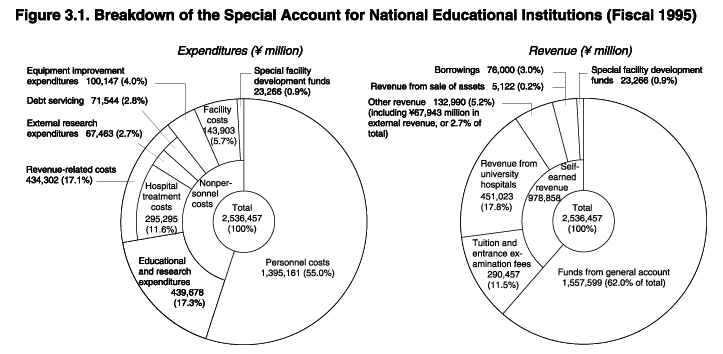| Home > Policy > White Paper, Notice, Announcement > White Paper > JAPANESE GOVERMENT POLICIES IN EDUCATION, SCIENCE, SPORTS AND CULTURE 1995 > Remaking Universities Chapter 3 Section 1 2 | ||
Higher education has become increasingly important as a means of maintaining Japan's social vitality and improving national living standards. The Government recognizes the important role played by higher education and is working to expand fiscal support for national, local public, and private universities and other institutions of higher education.
In 1964 the Special Account for National Educational Institutions was established to provide for the operation of national educational institutions, including universities. This special account is managed separately from the general account in order to clarify the accounting of national educational institutions while contributing to the enhancement of their activities. In fiscal 1995 the special account budget was 2,513,200 million yen. The largest source of funding for the special account was transfers from the general account, which amounted to 1,557,600 million yen(62% of total funding). Revenue from university hospitals contributed 451,000 million yen(17.8%), and tuition and other student fees 290,500 million yen(11.5%).
Transfers from the general account made up 82.1% of the special account budget when the system was first established and peaked at 83.5% in fiscal 1971. The percentage declined gradually in subsequent years due to the severe budgetary constraints facing the Government, and at one point it fell below 60%. For the past few years the contribution has remained at the low end of the 60%-70% range. There has been a gradual increase in the contribution from self-earned revenue, including not only tuition and other student fees but also external revenue, including scholarship loan donations, and income generated by joint research and commissioned research with private-sector organizations. This indicates that national institutions of higher education have responded actively to the needs of society through the formation of research cooperation mechanisms ( Figure 3.1 ).
Under the provisions of the Law Concerning Support for Private School Promotion, the Government provides subsidies to private institutions of higher education. These subsidies are used primarily to maintain and improve the educational and research environment and to alleviate students' financial burden. The Government provides subsidies for current expenditures and long-term, low-interest loans for the improvement of facilities and equipment through the Japan Private School Promotion Foundation.
Subsidies for the current expenditures of private institutions of higher education were introduced in fiscal 1970. Subsidies were increased until fiscal 1982, and subsidies as a percentage of total current expenditures also rose, reaching 29.5% in fiscal 1980. From fiscal 1982 onward there was a tendency to curb the total amount of subsidies for reasons that included the tight fiscal situation facing the Government as well as the recommendations of the Ad Hoc Commission on Administrative Reform. This led to increased weighting of subsidies according to the state of the educational and research environment and to the expansion of special subsidies for educational and research projects with high social significance. Because the considerable rise in student and faculty numbers led to higher current expenditures, however, the share of subsidies in current expenditures fell to 12.4% in fiscal 1993.
Government support for the improvement of facilities and equipment in private institutions of higher education include subsidies for large-scale educational and research equipment (9,250 million yen budgeted in fiscal 1995) and for research facilities (2,753.36 million yen budgeted in fiscal 1995). In addition, the Japan Private School Promotion Foundation provides long-term, low-interest loans. School corporations that establish professional training colleges receive subsidies for the purchase of major educational equipment, such as computers.
The greatest source of funding for local public institutions of higher education is budget expenditures by the local governments establishing such institutions. The Government provides subsidies for medical, dental, and nursing colleges. These subsidies, for which 5,000 million yen was budgeted in fiscal 1995, are used in part for current expenditures and improvement of educational facilities. Efforts are also being made to enhance measures under the local allocation tax system.
In addition to institutional subsidies for institutions of higher education, the Government provides grants-in-aid for scientific research to promote research in institutions of higher education (92,400 million yen budgeted in fiscal 1995). This financial support is available to individual researchers at all institutions of higher education, whether national, local public, or private. The Government also provides support through the student aid program administered by the Japan Scholarship Foundation, which received a Government loan of 81,300 million yen and 42,500 million yen in treasury investments and loans in fiscal 1995. Another channel for Government support is research scholarships for outstanding young researchers and research fellowships provided by the Japan Society for the Promotion of Science (6,400 million yen budgeted in fiscal 1995).

| Back to Top | MEXT HOME |